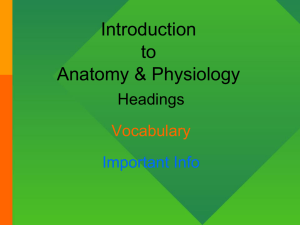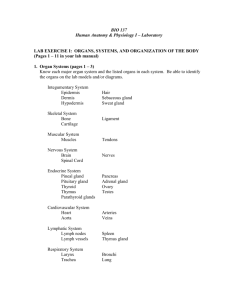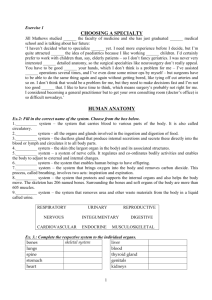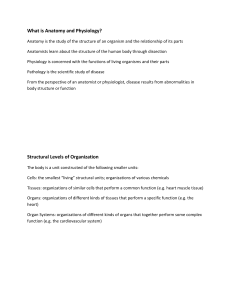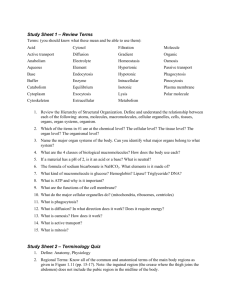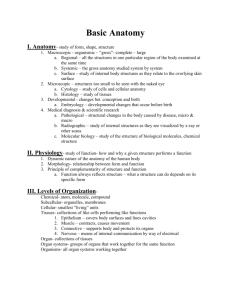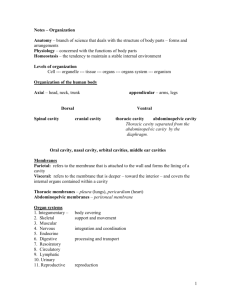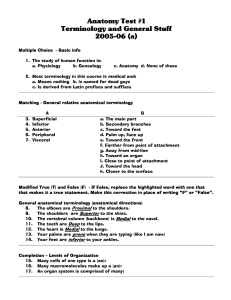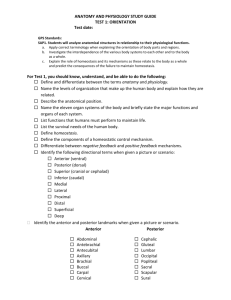Class # 2
advertisement
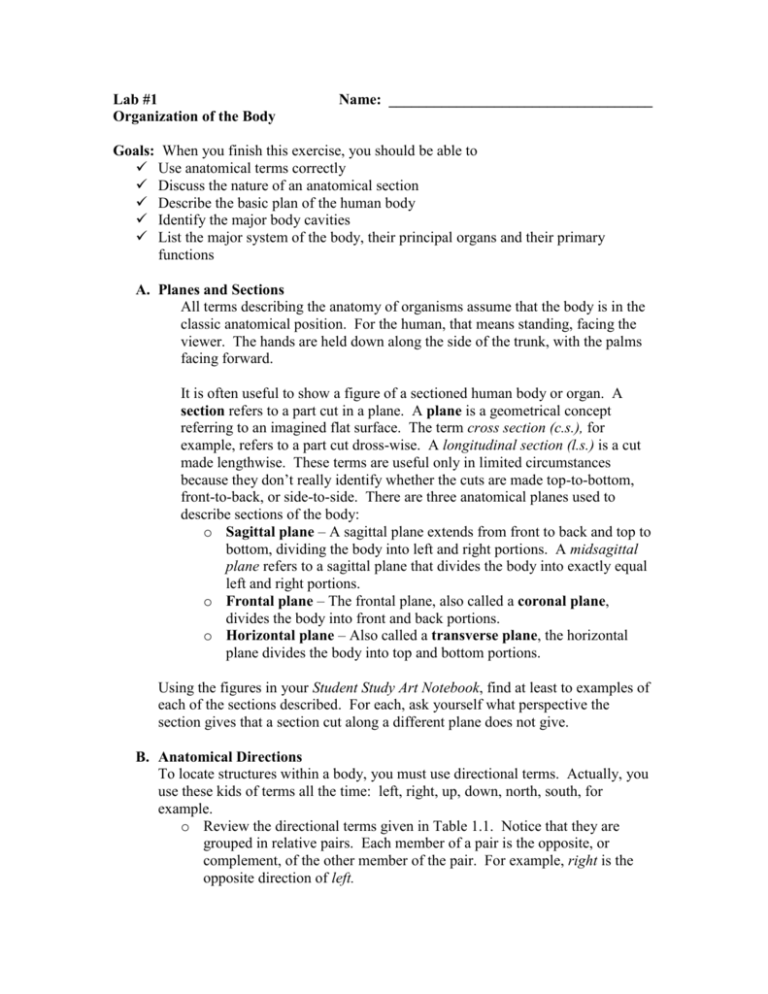
Lab #1 Organization of the Body Name: ___________________________________ Goals: When you finish this exercise, you should be able to Use anatomical terms correctly Discuss the nature of an anatomical section Describe the basic plan of the human body Identify the major body cavities List the major system of the body, their principal organs and their primary functions A. Planes and Sections All terms describing the anatomy of organisms assume that the body is in the classic anatomical position. For the human, that means standing, facing the viewer. The hands are held down along the side of the trunk, with the palms facing forward. It is often useful to show a figure of a sectioned human body or organ. A section refers to a part cut in a plane. A plane is a geometrical concept referring to an imagined flat surface. The term cross section (c.s.), for example, refers to a part cut dross-wise. A longitudinal section (l.s.) is a cut made lengthwise. These terms are useful only in limited circumstances because they don’t really identify whether the cuts are made top-to-bottom, front-to-back, or side-to-side. There are three anatomical planes used to describe sections of the body: o Sagittal plane – A sagittal plane extends from front to back and top to bottom, dividing the body into left and right portions. A midsagittal plane refers to a sagittal plane that divides the body into exactly equal left and right portions. o Frontal plane – The frontal plane, also called a coronal plane, divides the body into front and back portions. o Horizontal plane – Also called a transverse plane, the horizontal plane divides the body into top and bottom portions. Using the figures in your Student Study Art Notebook, find at least to examples of each of the sections described. For each, ask yourself what perspective the section gives that a section cut along a different plane does not give. B. Anatomical Directions To locate structures within a body, you must use directional terms. Actually, you use these kids of terms all the time: left, right, up, down, north, south, for example. o Review the directional terms given in Table 1.1. Notice that they are grouped in relative pairs. Each member of a pair is the opposite, or complement, of the other member of the pair. For example, right is the opposite direction of left. Table 1.1 Directional Term Left Definition Right Lateral Medial Anterior To the left of the body (not your left, the subject’s) To the right of the body or structure being studied Toward the side; away from the midsagittal plane Toward the midsagittal plane; away from the side Toward the front of the body Posterior Superior Toward the back (rear) Toward the top of the body Inferior Dorsal Towards the bottom of the body Along (or toward) the vertebral surface of the body Along (toward) the belly surface of the body Toward the trunk (describes relative position in a lib or other appendage) Away from the trunk or point of attachment Toward an internal organ; away from the outer wall (describes positions inside a body cavity) Toward the wall; away from internal structures Ventral Proximal Distal Visceral Parietal Deep Superficial Toward the inside of a part; away from the surface Toward the surface of a part; away from the inside Example of usage The stomach is to the left of the liver. The right kidney is damaged. The eyes are lateral to the nose. The eyes are medial to the ears. The nose is on the anterior of the head. The heel is posterior to the toes. The shoulders are superior to the hips The stomach is inferior to the heart. Her scar is along the dorsal surface. The navel is on the ventral surface. This joint is proximal to the toe nail. The hand is distal to the elbow. This organ is covered with the visceral layer of the membrane. The abdominal cavity is lined with a parietal peritoneal membrane. The thigh muscles are deep to the skin. The skin is a superficial organ. C. Body cavities and regions The inside of the human body contains the viscera, or internal organs. The viscera are found in any of a number of cavities (spaces) within the body. The two principal body cavities are the dorsal body cavity and ventral body cavity. Because these spaces are so large, they are subdivided into smaller units. o Using your Student Study Art Notebook, find these divisions of the dorsal body (and organs within): Cranial cavity – within the skull Organ: brain Vertebral Canal – within the vertebral column Organ: spinal cord o Find these divisions and organs of the ventral body cavity: Thoracic cavity – within the rib cage Organs: lung, heart, trachea, esophagus Abdominopelvic cavity – from the diaphragm to the bottom of the trunk. Abdominal cavity – from the diaphragm to the rim of the pelvic bones Organs: stomach, liver, most of the intestines, pancreas, spleen, kidneys Pelvic cavity – from the pelvic rim to the floor of the trunk Organs: portions of the intestines, ovaries, uterus, urinary bladder o Because the Abdominopelvic cavity is so large, and contains so many different organs, it is often convenient to subdivide it into nine Abdominopelvic regions. The regions are bounded by a grid made by imagining two horizontal planes (one just below the ribs, the other just above the hip bones) and two sagittal planes (each just medial to a nipple). This arrangement forms a 3-D, tic-tac-toe grid in the Abdominopelvic cavity. Identify the approximate locations of each of the nine regions on a model of the human torso. Right hypochondriac region – top right region (hypochondriac means “below (rib) cartilage”) Epigastric region – top middle region (epigastric means “near the stomach”) Left hypochondriac region – top left region Right lumbar region – middle right region (lumbar refers to lumbar vertebrae in lower back) Umbilical region – central region (umbilical refers to the umbilicus, or navel) Left lumbar region – middle left region Right iliac region – lower right region (iliac refers to ilium, the bowllike part of the hip bone) Hypogastric region – lower middle region (hypogastric means “below the stomach”) Left iliac region – lower left region D. Surface Regions There are hundreds of terms that describe specific locations on the surface of the human body. These names are useful for identifying not only surface features but also underlying muscles, bones, nerves, and blood vessels. In this activity, locate regions named by a few of the more common terms. o Locate the following surface regions on a human figure: Abdominal – area overlying the abdominal cavity. Acromial – the point of the shoulder. Antebrachial – forearm Axillary – armpit Brachial – upper arm Buccal – cheek Carpal – wrist Celiac – abdomen Cephalic – head Cervical – neck Costal – ribs Coxal – hips Crural – leg Cubital - elbow Digital – finger Dorsal – back Femoral – thigh Frontal – forehead Genital – reproductive organs Gluteal – buttocks Inguinal – groin Lumbar – the region of the lower back between the ribs and the pelvis Mammary - breast Mental – chin Nasal – nose Occipital – the lower posterior region of te head. Oral – mouth Orbital - eye cavity Otic – ear Palmar – palm of the hand Patellar – knee Pectoral – chest Pedal – foot Pelvic – pelvis Perineal – the region between the anus and the external reproductive organs Plantar – sole of the foot Popliteal – area behind the knee Sacral – posterior region between the hipbones Sternal – middle of the thorax, anteriorly. Tarsal – instep of the foot Umbilical – navel Vertebral – spinal column E. Body Systems As you know, the human organism is composed of organ groups called systems. The organs of a system work together in an organized manner to accomplish the function(s) of the system. As an introduction to human body systems, study Table 1.2. Each of the systems will be discussed in more detail later in this course. Table 1.2 Organ System Integumentary Skeletal Principal Organs Skin Bones, ligaments Primary Function(s) Protection, temperature regulation, sensation Support, protection, movement, mineral/fat Urinary Skeletal muscles, tendons Brain, spinal cord, nerves, sensory organs Pituitary gland, adrenals, pancreas, thyroid, parathyroids, other glands Heart, arteries, veins, capillaries Lymph nodes, lymphatic vessels, spleen, thymus, tonsils Lungs, bronchial tree, trachea, larynx, nasal cavity Stomach, intestines, esophagus, liver, mouth, pancreas Kidneys, ureters, bladder, urethra Male reproductive Female reproductive Testes, vas deferens, prostate, seminal vesicles, penis Ovaries, fallopian tubes, uterus, vagina Muscular Nervous Endocrine Cardiovascular Lymphatic Respiratory Digestive storage, blood production. Movement, posture, heat production Control/regulation/coordination of other systems, sensation , memory Control/regulation of other systems Exchange and transport of materials Immunity, fluid balance Gas exchange, acid-base balance Breakdown and absorption of nutrients, elimination of waste Excretion of waste, fluid and electrolyte balance, acid-base balance Continuation of genes (reproduction) Reproduction, nurturing of offspring
